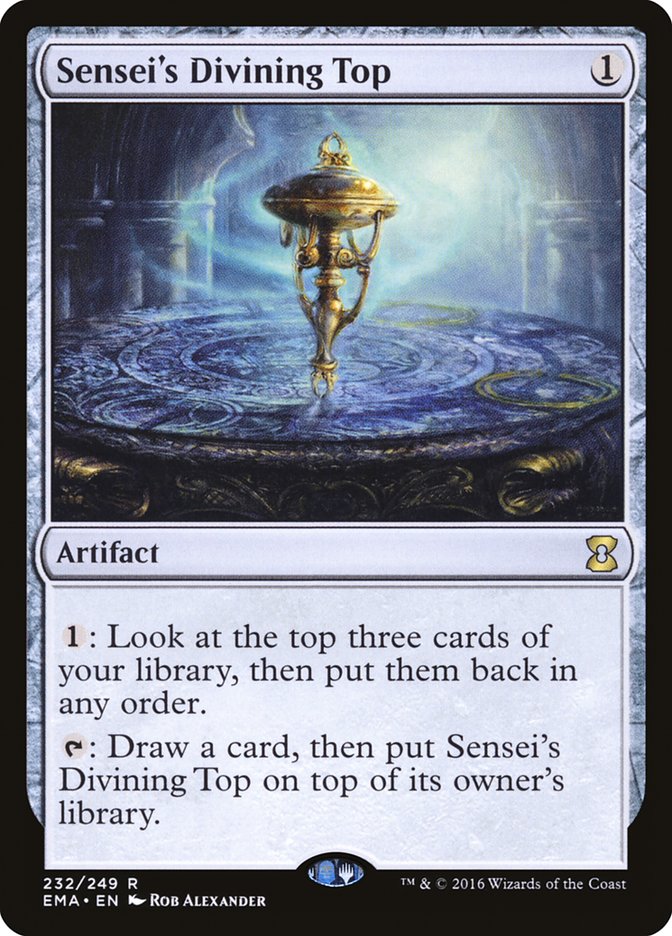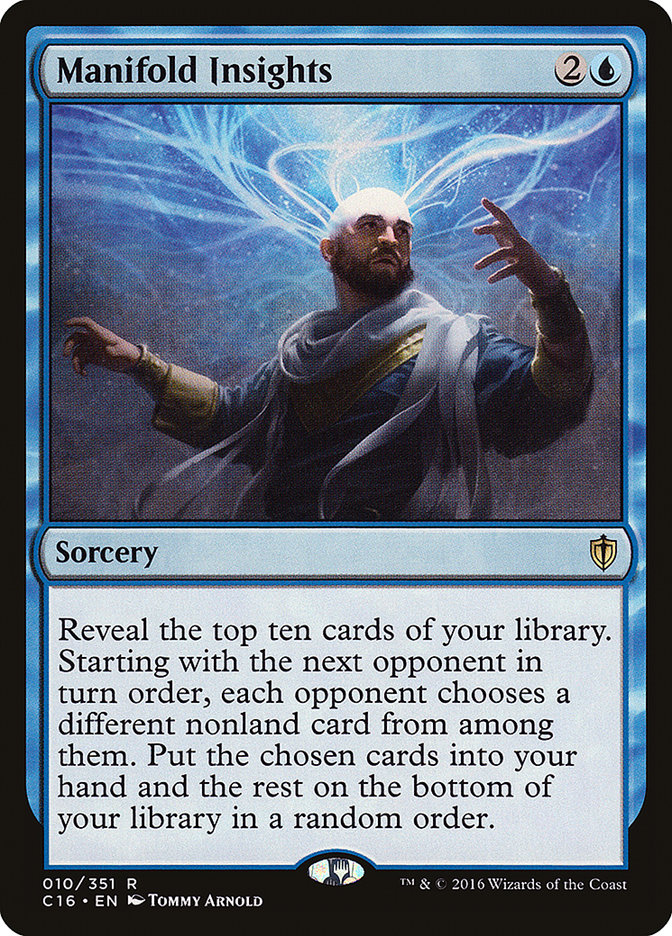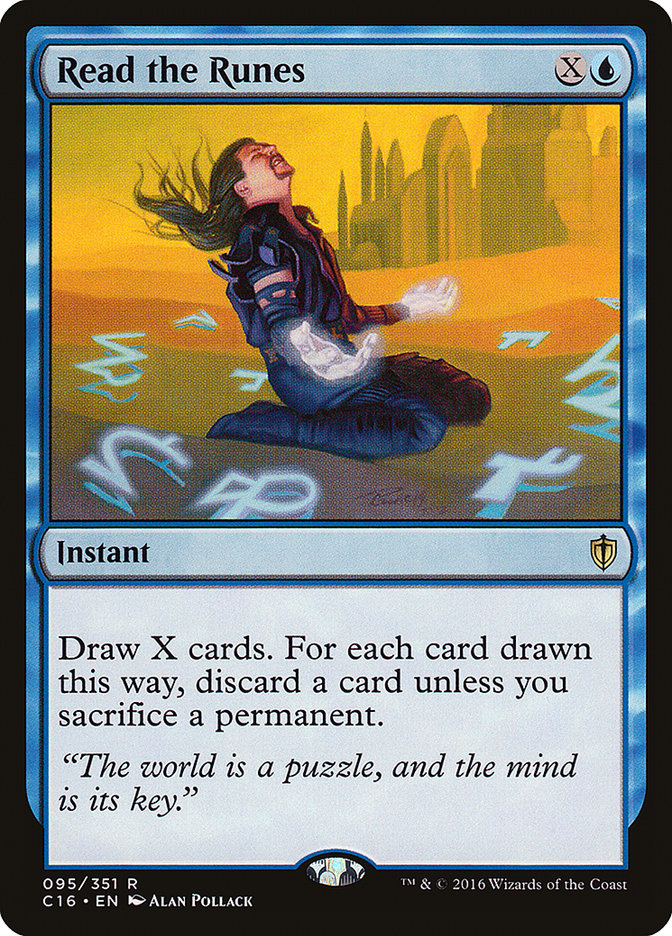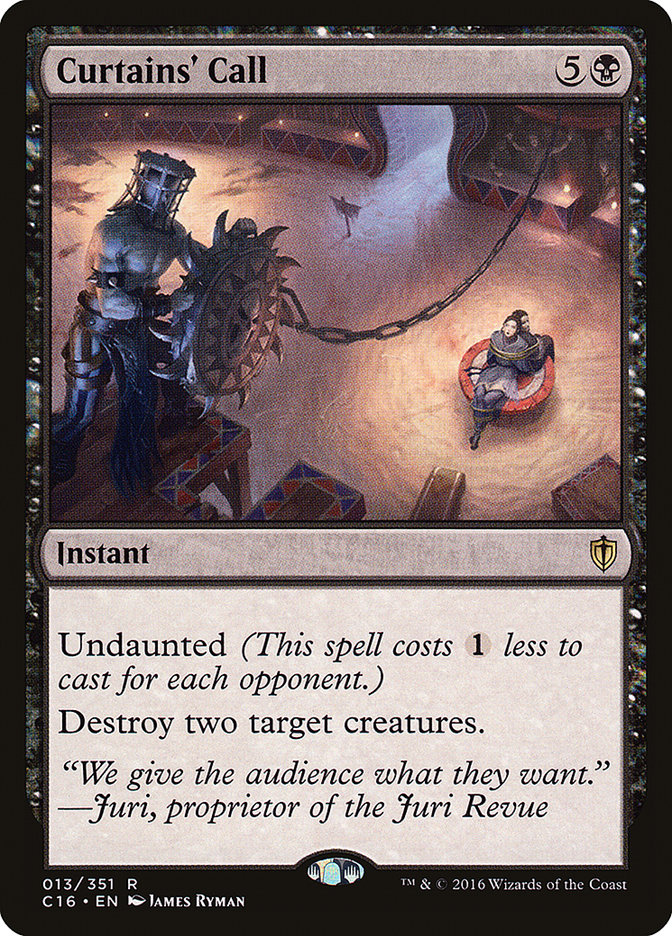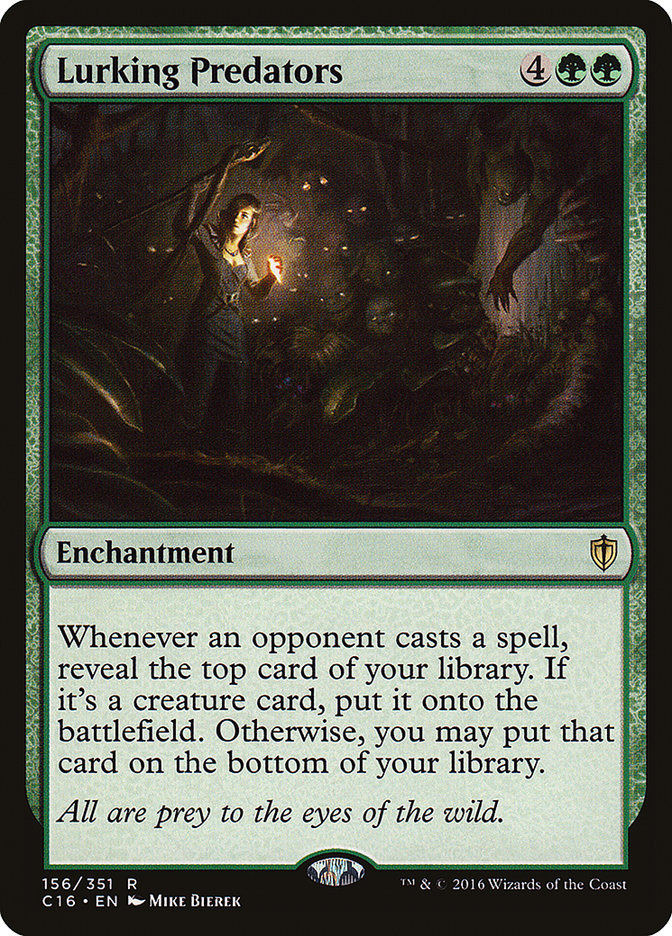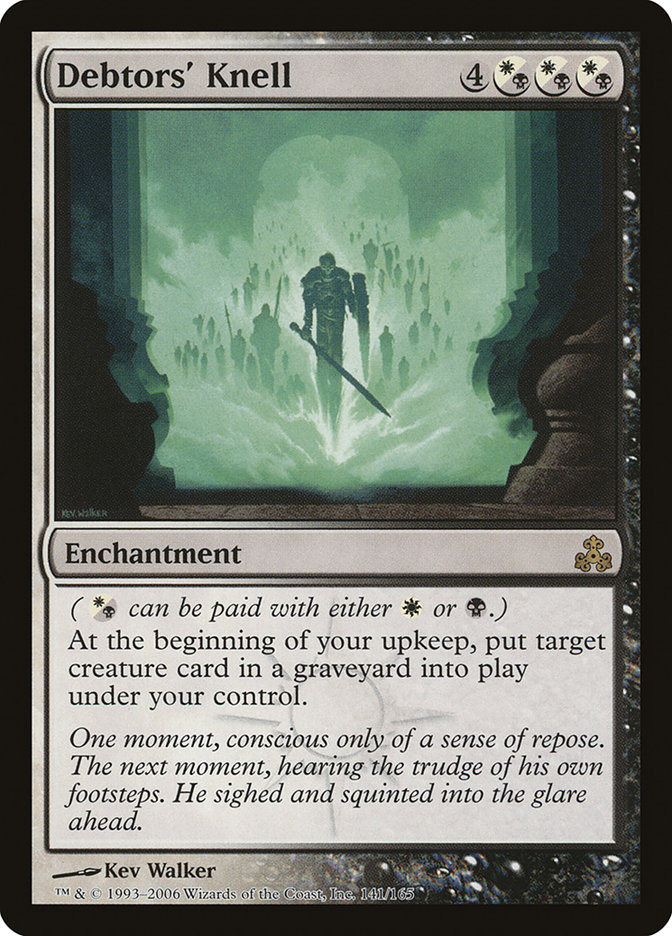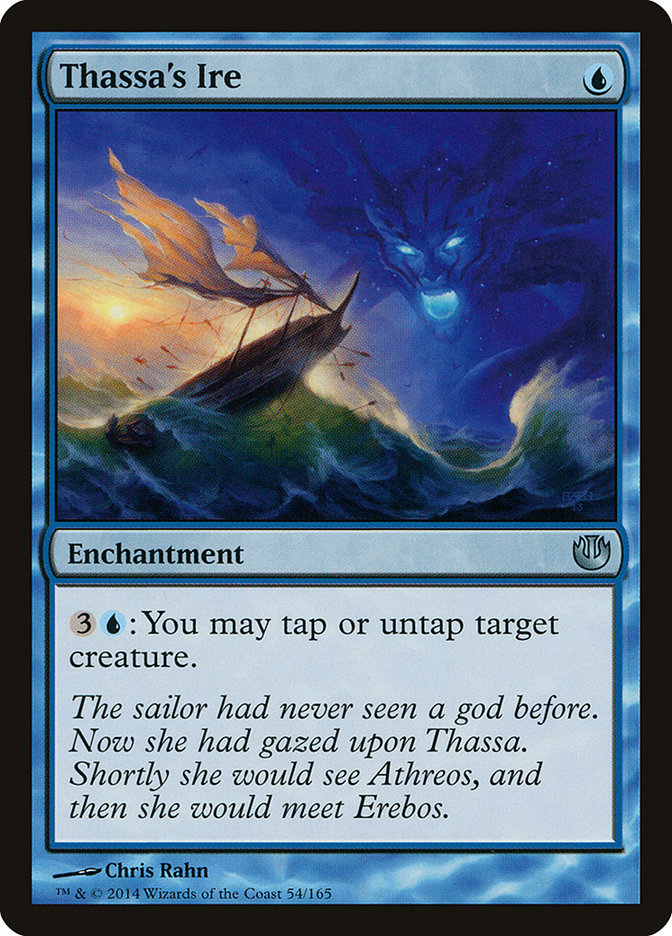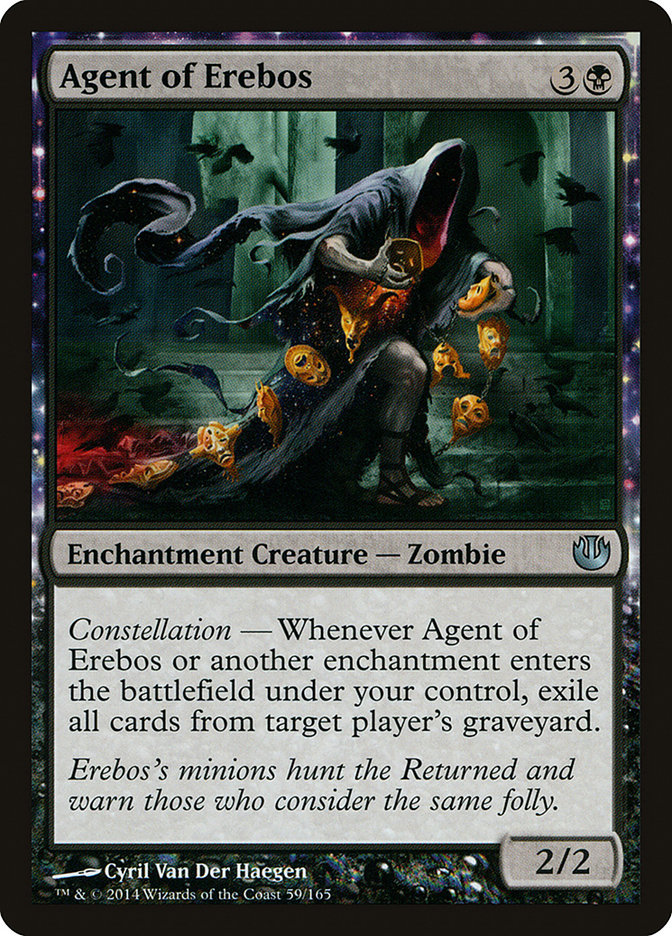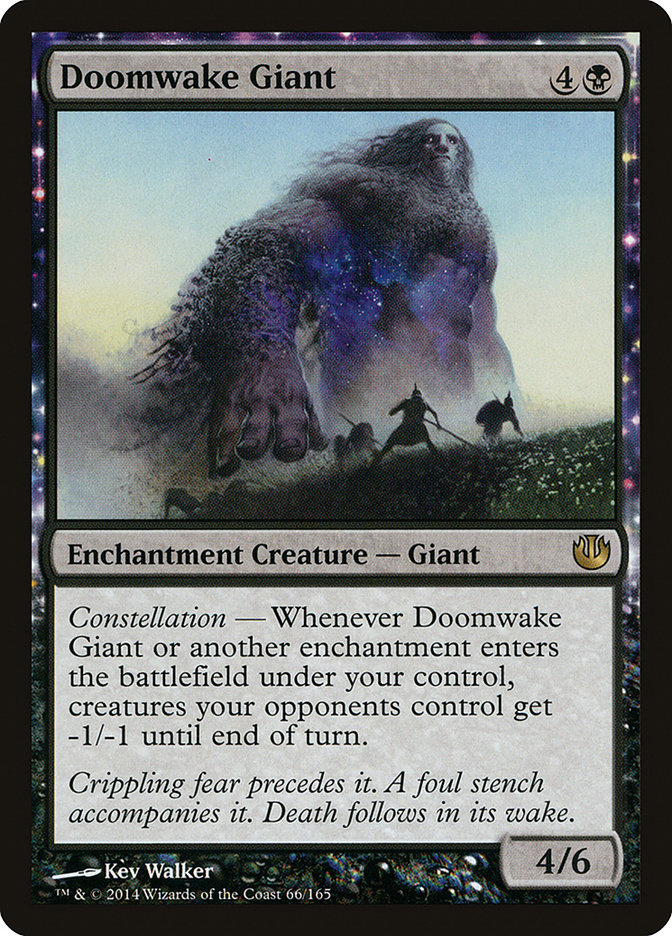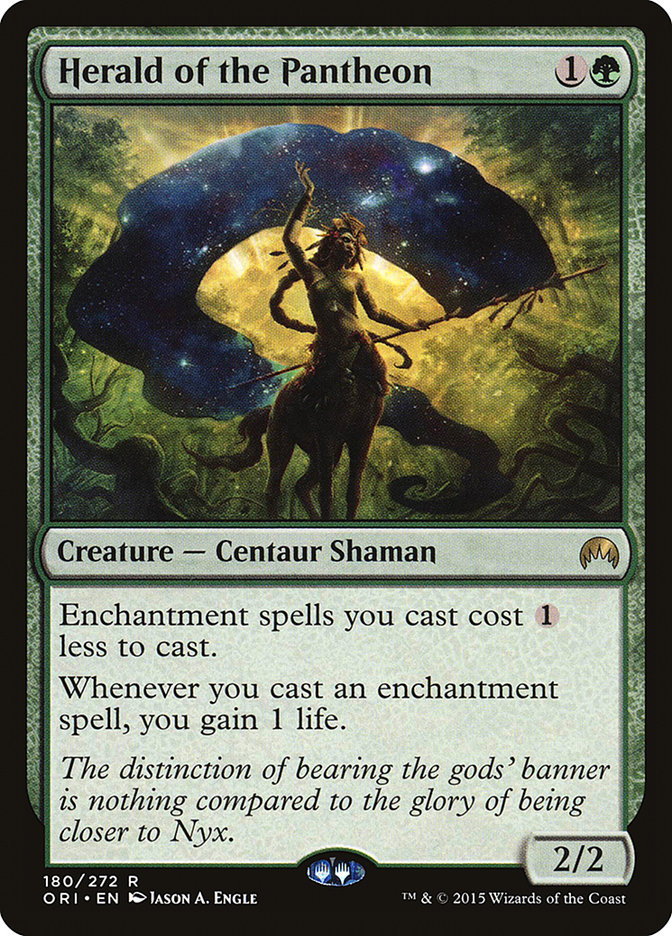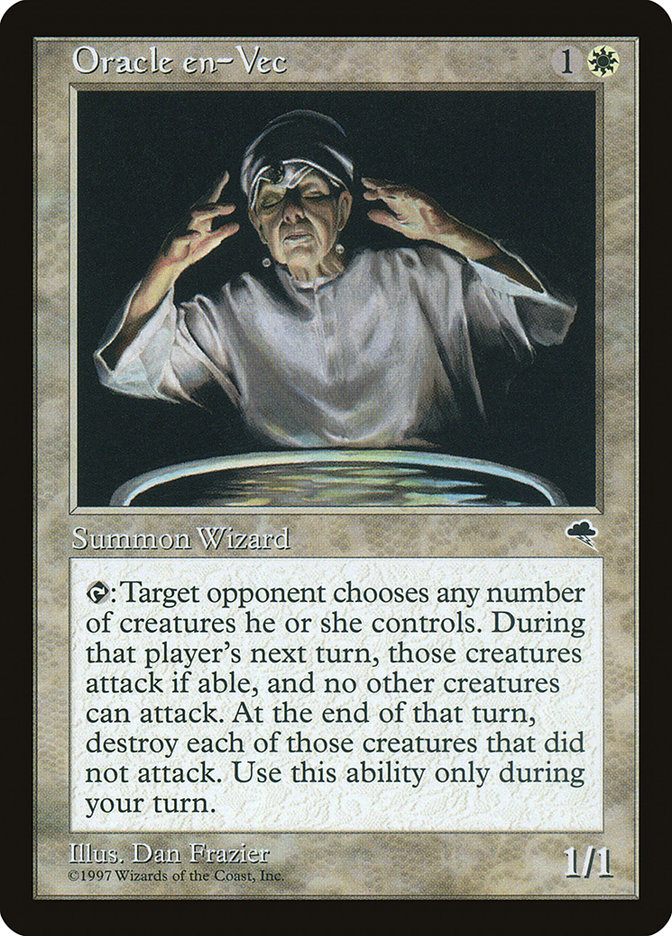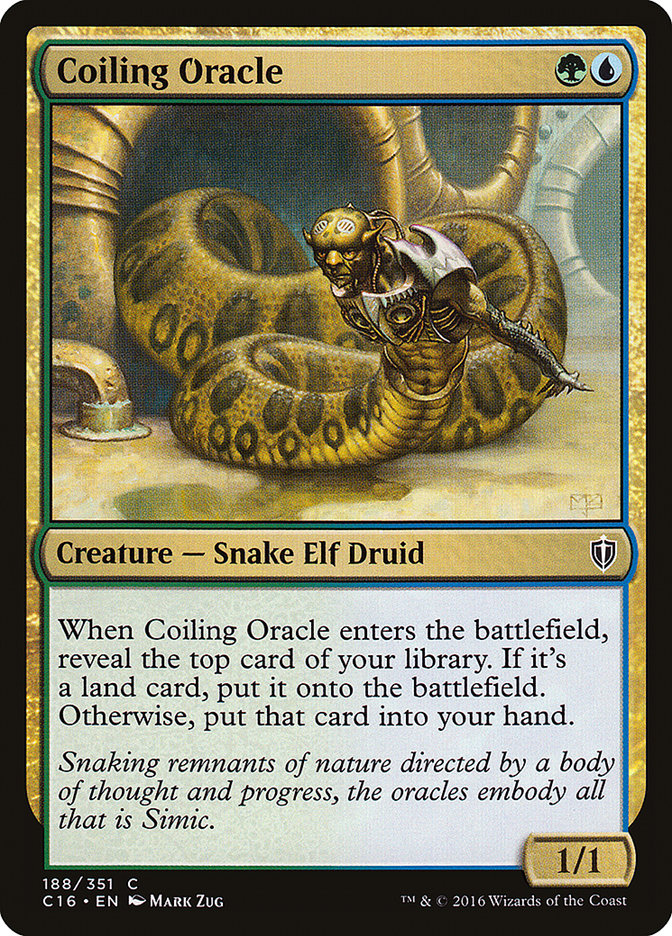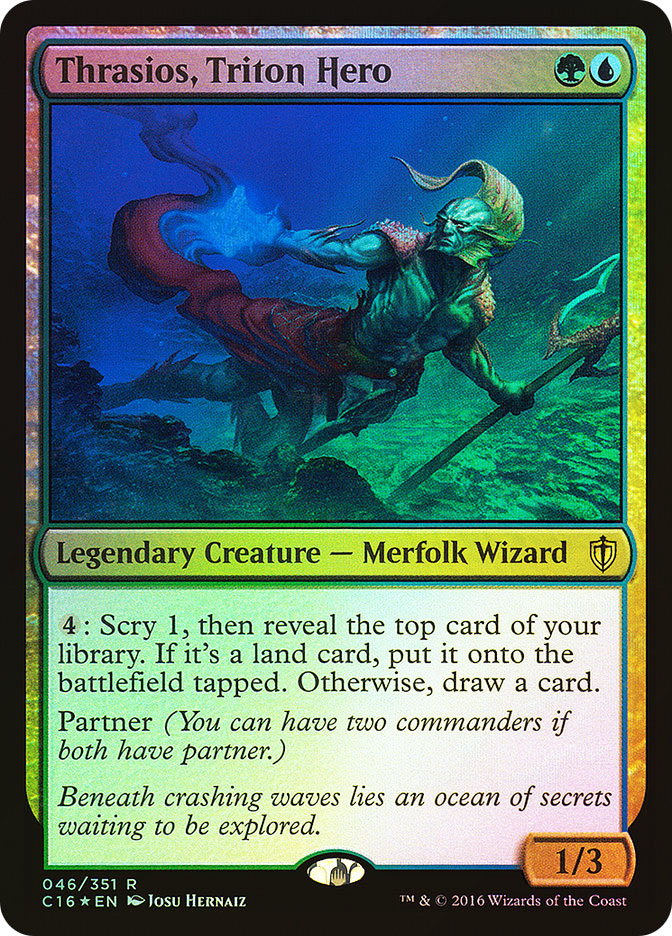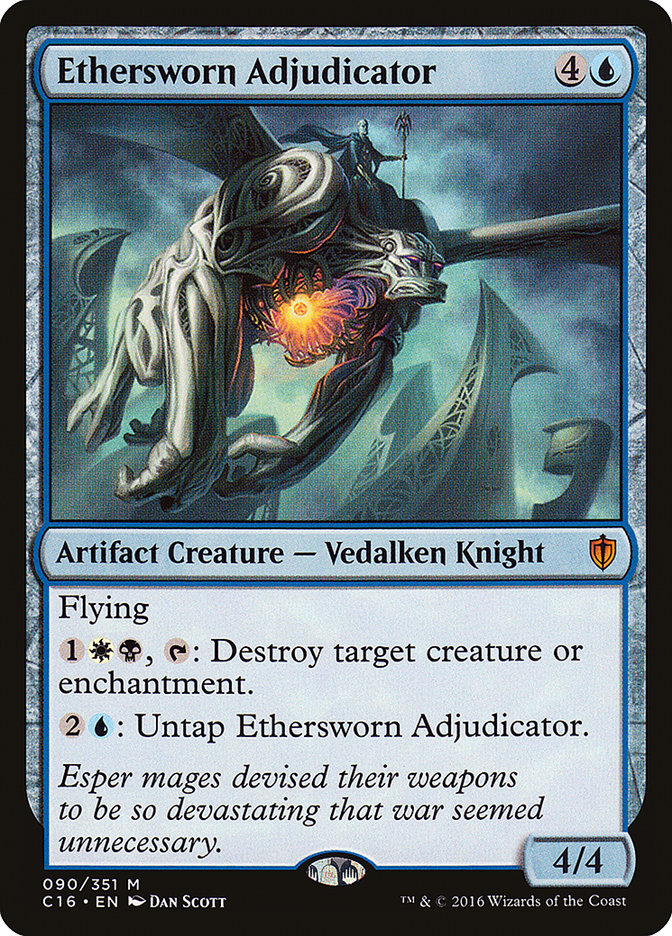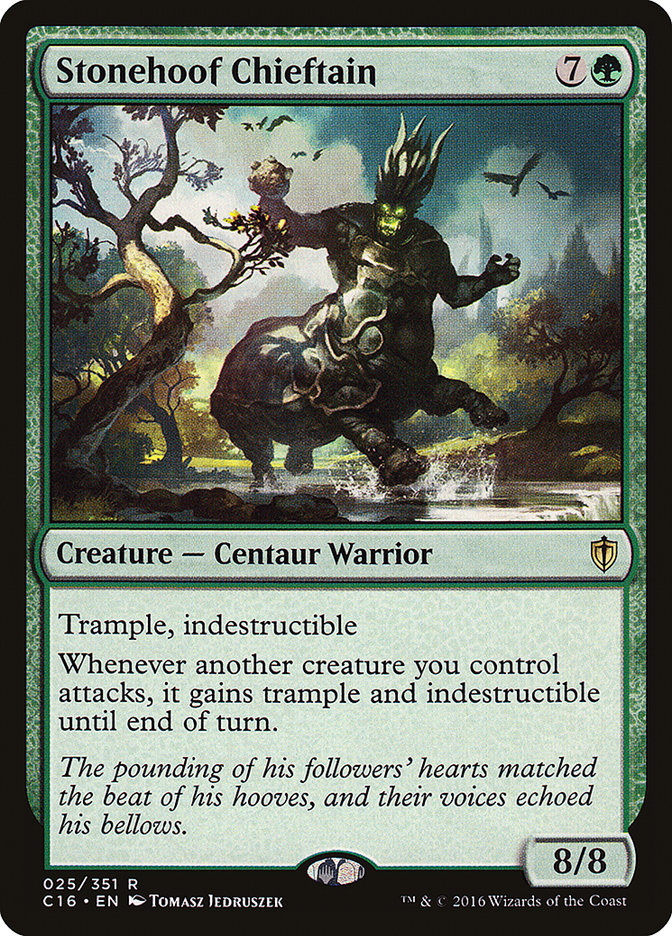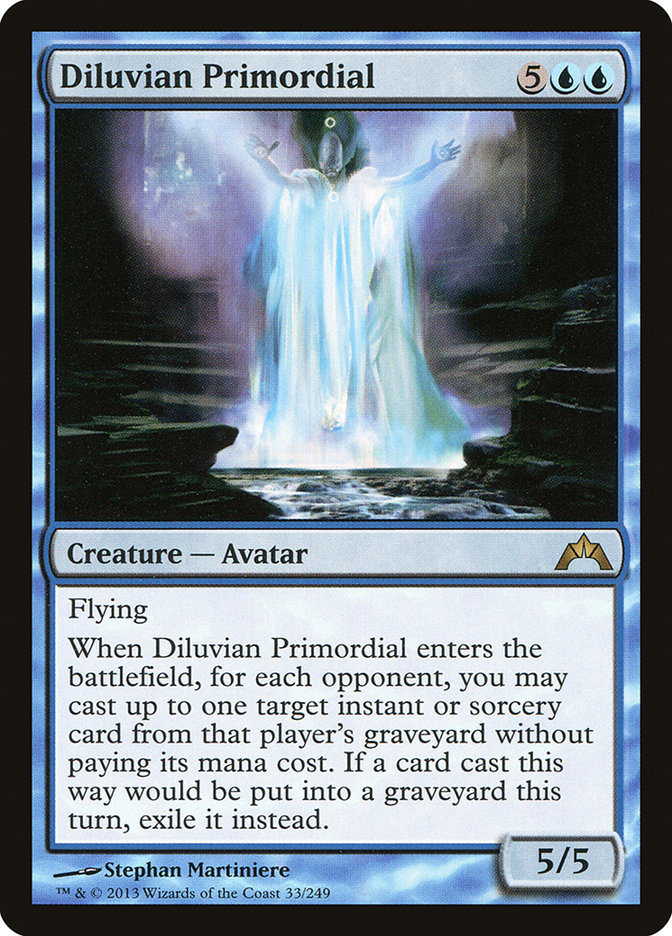Dear Azami,
Hoo boy.
I never expected to get all that excited over this year’s Commander decks. Four-color commanders felt like box-checking to me; I just didn’t see the appeal. Besides, I don’t like running too many colors in my decks anyway. I have too many ideas for what I want the deck to do and then everything gets all muddled together. But then they revealed the cards.
Despite sharing an epithet with her, I will not be building Saskia immediately, as I’m still mad at her for not being an Abzan-Mardu hybrid leader of Krumars. Please, don’t ask. Instead, I’m looking forward to trying out the U/G oracle I have been waiting for since Theros block.
This is Kydele. She has too many ideas too. Despite her best efforts to cover her eyes, they can never unsee the myriad possibilities here. Tymna has the right idea; she’s just blocked off sight entirely. Not only do these two synergize mechanically, they also happen to be two of the only Partner commanders that would actually make sense working together. I’m a fan, and I do love me some Greek mythology.
Commander(s): Kydele, Chosen of Kruphix and Tymna the Weaver
Act of Authority
Arcane Sanctum
Archmage Ascension
Athreos, God of Passage
Azorius Chancery
Bastion Protector
Behold the Beyond
Bident of Thassa
Blossoming Sands
Bring to Light
Broodbirth Viper
Chasm Skulker
Command Tower
Commune with the Gods
Damia, Sage of Stone
Dark Prophecy
Daxos of Meletis
Deadbridge Chant
Diabolic Revelation
Dictate of Karametra
Dictate of Kruphix
Dimir Aqueduct
Dismal Backwater
Diviner Spirit
Diviner’s Wand
Dreadbringer Lampads
Drogskol Reaver
Eidolon of Blossoms
Emrakul, the Promised End
Enter the Infinite
Erebos, God of the Dead
Etched Oracle
Evolving Wilds
Forest
Forgotten Creation
Galvanic Alchemist
Gift of Immortality
Golgari Rot Farm
Helix Pinnacle
Hoofprints of the Stag
Horizon Chimera
Hydra Broodmaster
Island
Jungle Hollow
Kiora, Master of the Depths
Kozilek, the Great Distortion
Kruphix, God of Horizons
Lorescale Coatl
Medomai the Ageless
Mind Unbound
Mind’s Dilation
Nightmarish End
Nylea, God of the Hunt
Opulent Palace
Orzhov Basilica
Overbeing of Myth
Painful Truths
Plains
Plea for Guidance
Price of Knowledge
Psychosis Crawler
Recurring Insight
Reliquary Tower
Rescue from the Underworld
Rupture Spire
Sage of Ancient Lore
Sandsteppe Citadel
Scoured Barrens
Sea Gate Oracle
Seaside Citadel
Selesnya Sanctuary
Simic Growth Chamber
Sturmgeist
Swamp
Temple of Deceit
Temple of Enlightenment
Temple of Malady
Temple of Mystery
Temple of Plenty
Temple of Silence
Temple of the False God
Terramorphic Expanse
Thassa, God of the Sea
The Great Aurora
Thornwood Falls
Thousand-Year Elixir
Tranquil Cove
Transguild Promenade
Triad of Fates
Venser’s Journal
War Oracle
Well of Ideas
Well of Lost Dreams
Whip of Erebos
Whitewater Naiads
Windreader Sphinx
Worst Fears
Initially, I wanted this to be a very flavorful Prophets-and-Oracles deck, keeping it all on-theme with lots of Gods and other Theros cards. Then I started looking into mana sinks for Kydele to power, and the Eldrazi decided to show up. Then I realized we needed to enable Tymna as well, and started getting into creatures and lifegain. Then I noticed how many enchantments I had and tried to bring in a Constellation package, and… well, here we are. A lot of cards with not a lot of focus. I am fully aware that I am trying to do too much here, but it’s all a bit overwhelming for me – hopefully you will be able to make some sense of it. We have the visions, you tell us what they mean, yeah?
Thanks so much for taking a look, and I look forward to seeing what you can do with it!
Jaymic
This one’s a hard one mostly because flavor is the toughest constraint of them all – this flavor theme is all about oracles and visions and the Gods themselves, but that doesn’t necessarily result in a playable deck because that’s going to naturally over-value card draw and not play nearly enough stuff like, say, mass removal. So I’m going to try to operate to build you the best deck I can that has this flavor to it, not necessarily the best Kydele-and-Tymna deck I possibly could… which means skipping the first thing I would think of doing, swapping out Kydele, Chosen of Kruphix for Thrasios, Triton Hero.
When looking for Partner synergies, the list of things I’m potentially interested in as common themes actually includes “Card Draw commanders” as two things that might work well together, so having one of your partner commanders draw cards in way X and the other draw cards in unrelated way Y is potentially more synergistic than, say, having one draw cards and the other get a more potent ability as you draw more cards. This same logic has led me to conclude that both the Orzhov and Simic commanders would be great as partners at the helm of two-color decks, too… but that’s not the mission you’ve given me, so we’re going to not harsh your enjoyment of the flavor, and that means following some rules.
If I don’t think it’s good for the deck, I cut it and try to replace it with something also on-theme if possible; if not possible, I will try to at least replace it with something else from the Commander 2016 card pool instead of digging into the literal 10,000 possible options you can consider for a four-color deck. Where neither of those options is possible, I will hunt down the right card that fits the exact specific need in order to give the deck the right balance to it, but I’ll at least try to keep it on-theme or use cards from the same card pool first.
We’re going to start by re-balancing the deck’s manabase because it is definitely out of whack. You only have 33 lands to begin with, and of those 33 a whopping 26 enter the battlefield tapped – we’re going to find it very difficult to play our spells on time with a build like this, making both Kydele and Tymna much worse because they’re now four- and five-drops instead of three- and four-drops. I counted 98 cards in the deck instead of 99 so we have one free slot we can fill here, but I’m going to want to add three more lands from other sections of the deck in order to get us up to 37… between the six Temples and six Ravnica bouncelands, this should be enough to get us up and running a decent amount of the time.
We’ll keep the four “free” basic lands and the cycle of Temples, Ravnica bouncelands, and the four Shards/Khans tri-lands plus Command Tower and Reliquary Tower. Everything else is getting slated for an upgrade, so we’re going to start by purging these:

I feel like Temple of the False God was just included for the God-related theme, and it’s especially bad in both a four-color deck with intensive mana costs and in a bounceland-heavy manabase, so we can’t let the flavor value override the fact that it often won’t tap for any mana at all. All of the rest are just too slow and need to be replaced with lands that at least have a chance of enter the battlefield untapped; I would have just said “enter the battlefield untapped,” except I decided the Kaladesh cycle of fastlands were the best remaining enemy-colored lands I could find and preferred them to, say, the enemy painlands from Magic Origins, even though they would have been cheaper on the budget and always start untapped. You’ll have enough lands that can enter the battlefield untapped to be able to sequence properly during your early turns, plus they’re stronger for longer in a bounceland-centric manabase, so they should help you cast both Kydele and Tymna on time – which is good enough for me.
Adding back in, I’m going to start with a second copy of each basic land – you’re no longer searching the right one out with Evolving Wilds or anything like that; we just want a decent chance of finding our colored mana on time and having some lands that enter the battlefield untapped without breaking the budget here. Then we have these:

I know I said I wanted lands that entered the battlefield untapped, but Mosswort Bridge has to be a ridiculously good addition in any deck with six bouncelands in it so in it goes anyway. Esper Panorama and Bant Panorama replace the Evolving Wilds and Terramorphic Expanse I’d cut earlier while still finding almost all the right lands anyway; they both get either blue or white and then one other color besides. If you want the full flexibility you can get out of these instead, you can instead go with Terminal Moraine and Warped Landscape… I’d rather pay one mana than two, though, so I figured these would work in most cases.
Reflecting Pool happens to also dabble into the oracular ability theme a little bit, since oracles and scrying pools tend to occupy the same space, but it’s a weak association… mostly I just needed good multicolor lands that didn’t start tapped and was willing to excuse the cost in order to get it. Exotic Orchard will probably do everything you need it to in most games and was also in the Commander 2016 card pool, so I figure we’ll go with it even though it’s not one of my favorite lands. It’ll do good work and we must admit the price is right for our needs here.
Instead of the six-card cycle of enters-the-battlefield-tapped cheap two-color lands you’d started with, I went with the three Odyssey filter lands you’re allowed to play and the three Kaladesh fastlands. this constitutes the bulk of the cost going into your manabase, but they’re still far cheaper than Ravnica shocklands would have been and we really need lands we can tap for mana immediately so we don’t trip over too many lands that start out tapped.

Moving on to the artifacts, I’m cutting the Venser’s Journal for just not doing enough – five mana is a lot for a Spellbook, and I don’t think the lifegain is anywhere near worth either the mana that’s being asked for here or the opportunity cost of including the spell in your deck – and Thousand-Year Elixir because it combines with so very few of your creatures in the first place. This looks like it’s just here to try to abuse with Kydele, and we’re not actually that interested in trying to tap her multiple times… when both of your commanders are working at the same time, she’ll be most powerful to tap during your end step anyway, which is the wrong time to cast big creature spells like those Eldrazi you were interested in, so I’m going to settle for her being good enough as an Elf-plus rather than going far out of my way to try to abuse her ability by going infinite with her or drawing four or more cards a turn. She’ll tap for two or three mana with fair regularity, but the work we need to put into doing more than that is not worth putting in just to get some extra mana out.
I only have one card I want to add back in here, since we need to shave three more slots to make room for lands… and that addition is the one I’ve mostly been shying away from in recent weeks:
Normally I fret the cost here and don’t add it in order to come in under a reasonable budget, but also because it’s a boring addition and if my first suggestion every week was “shuffle the deck and cut, remove a card at random, and add Sensei’s Divining Top to make the deck better,” then it would be very reasonable for every reader to click the back button right about now and for readers to follow that exact boring and mechanical formula themselves instead of writing up decks to submit to me. But in this particular case, we’re talking about the thematic flavor of divination – how could we not add a Top here?
The budget will work out fine in the end anyway; thankfully the Eternal Masters set has helped cut this back down towards a reasonable cost.
Moving on to the spells, here’s where I really have to pull out my hacksaw. Too many of these cards just focus on getting more cards in your hand. Not enough of them actually do something – the balance is way off.
Out:

Two slots are going to be cut in order to fill out the manabase, so that leaves us with fourteen holes to fill. First we’ll add in some mass removal so you can actually come back from behind sometimes. Then we’ll look more closely at the rest of the themes we have going on here.
In:

Four out of the five are in the Commander 2016 decks, so we’re at least pulling from the same card pool, even though we can’t find mass removal spells that focus on oracular ability in their theme or flavor. I don’t really want to blow up your side of the battlefield, so we’ve picked the removal spells that are best able to leave your side of the table intact. The only one that breaks that rule is Sublime Exhalation, which was picked to “just” be the cheap Wrath when we need one, but if you want to stay on-theme and keep things one-sided, feel free to reach for Necromantic Selection instead. The price is certainly right, though I do worry a little about the triple black mana casting cost, which prompted me to cut Dark Prophecy in the first place.
Sticking with the theme of visionaries and oracles, I want to add a pair of Commander 2016 draw spells back into the mix… I actually feel like I over-cut here, and did so knowing we could put a little bit of the flavor back in when I wanted to.
Admittedly, Manifold Insights doesn’t work with Kydele… but Read the Runes certainly does. It’s a situational spell, much stronger in response to a Wrath effect or when you don’t mind sacrificing a bunch of permanents, but the flavor is a stronger fit for the deck while the power level is more in place with where I think we should be reaching for. Any time someone casts Enter the Infinites and draws their deck, I’m instantly bored to tears.
I want a bit of pinpoint removal, preferably with a bit of utility to it, so we aren’t always forced to drop a Wrath effect just because there’s a problem on the battlefield. We’re playing good colors for versatile removal spells, so let’s add the following:

I’m a huge fan of Curtains’ Call and think it is my new go-to removal spell in this format; usually I like the cheapest removal possible and so I go looking for Swords to Plowshares, Slaughter Pact, or even Snuff Out from time to time, but three mana to kill two creatures is the kind of Murder I can get behind paying three mana for. We could sort of get this effect already with Malicious Affliction if we did a bit of set-up work first, but Curtains’ Call is the no-muss, no-fuss version. Mortify and Putrefy help us to manage artifacts and enchantments while we’re at it, and Sylvan Reclamation handles both of those expertly while also having a relevant mode that prevents it from rotting in our hands when it is not relevant to the battlefield state.
For the five slots remaining, I want to pick only enchantment cards because that is one of the themes that resonates most strongly for this deck – they turn on the Gods, they potentially do something useful and valuable turn after turn, or they otherwise can make our opponents’ lives miserable. There’s a reason I didn’t cut Mind’s Dilation in with all the rest; I think the enchantment theme is strongest and deserves bulking up here, so first we’ll add that particular enchantment’s obvious companion:
Of course, it doesn’t hurt that we’ve added a Sensei’s Divining Top, but it’d still be great without one. It’s not necessarily the most interesting addition, but it is one that makes a lot of sense.
Our next two additions are going to focus on attrition, following that same line of thought that Deadbridge Chant takes us down in order to grind out a little bit of extra value turn after turn. One of them will even focus on enchantments, bolstering the rest of that theme…
I still have fond memories of Starfield of Nyx, and this deck has just enough self-milling or ways to discard cards out of our hand in order to make it really beneficial for us even before the Opalescence effect turns on. I don’t think it gets explored enough, and this is definitely the right kind of deck to give it a try in… while Debtors’ Knell will just be a powerful reanimation effect turn after turn that will help bury any opponent when you start from an even battlefield state.
Our last two additions will be a bit cryptic, but look to the Oracle and all shall be explained.
Moving on to the creatures, I think some of the Constellation creatures aren’t working and the “enchantment creature” package isn’t really pulling its weight; we still need to have a good, playable deck in order to enjoy the Oracle-heavy experience. Some of the weaker cards will need to be cut even if they are very much on-theme for the rest of the deck, and I’ll try to keep some of the oracular theme present by at least cutting them for cheaper cards. I think there’s a little bit too much at the top end here and not enough early plays, which was also part of why we were cutting stuff like Enter the Infinites for the far-more-affordable Manifold Insights.
Out:

I do think the Constellation mechanic is potentially worth exploiting here; I just don’t think those were the right cards to do it with. I can think of two that were left out that are very relevant to the format, and we’ll add another small enchantment enabler here too while we’re at it:
While it’s probably not much more than a weak mana rock, this deck is in favor of adding some more two-drops to its package – Tymna draws cards as early as turn 3 if you have a two-drop on turn 2, which is part of why I want to try and drop the curve a bit here as you can build a lot of early advantage off cheap cardboard.
Let’s add some more two-drops while we’re at it, ones that even fit the flavor of the deck:
Coiling Oracle is great, always at least a cantrip and often a ramp effect while you’re at it, kind of an Elvish Visionary plus… and I was tempted to add Elvish Visionary too, because visions are what oracles have, but elected to go with the other Simic partner commander instead because that “4: Draw a card” ability can be both a great enabler for Kydele and a great place to sink her extra mana.
The third one is a little bit weird, but hey, getting weird is quite fun in this format. Remember those two tap enchantments I’d added? Sure, one of them can effectively replace Galvanic Alchemist as a way to profitably untap Kydele when you’ve drawn a lot of cards that turn, but that wasn’t the actual reason I included it – both were added to mess around with fate and expectations via Oracle en-Vec, figuring that at the very worst they’d help on defense by preventing too many attackers from pointing your way. Tap the Orace en-Vec and your opponent must lock into their attack plans; they don’t have to declare who they are attacking, but they do have to declare with whom. Any creature that is then fated to attack but cannot will be destroyed. Tap that creature to prevent it from attacking and you’ve effectively Murdered it.
There is some potential gamesmanship here – your opponent can just learn to declare no attackers whenever your little 1/1 taps their way, or they can declare all creatures as attacking and plan to overwhelm you while suffering a few casualties, a strategy no 1/1 creature is designed to defend against. You can even have a conversation as you look at your blue mana and contemplate Murdering their creature… “I’ll let your creatures live if you go and attack Bob over there instead of me” is the kind of table talk we often engage in during a game of Commander, and the Oracle opens up room for more of that kind of stuff while also playing directly with the forecasts and fate that serve as the central theme of the deck.
The rest of my additions don’t seem nearly as interesting by comparison… is it even worth spending words saying, “I am going to add Solemn Simulacrum because you’re a four-color deck that likes card advantage and needs mana fixing?” I’m going to, but it’s such a let-down to take a deck that I’m streamlining and add Sensei’s Divining Top and Solemn Simulacrum. I can’t exactly pat myself on the back like I was just clever or something.
Four more additions, three of which were selected because they fit what the deck wanted and pulled from the Commander 2016 card pool:
Ethersworn Adjudicator is “just” a solid creature with built-in removal, tapping to cast Mortify and then potentially doing so multiple times a turn when we get to the late stages of the game. We need some more removal and more fliers to attack our opponent and draw cards with Tymna, so I’m content to add it even if it’s not a flavor fit because it fills a useful role and is on-curve. Stonehoof Chieftain will let us make sure all of our creatures survive a mass removal effect we’re about to cast, and it’s covering for the fact that we don’t want to kill our own stuff but do need mass removal sometimes. Ikra Shidiqi, the Usurper is here because I think the deck needs a bit more lifegain – we can beneficially trade life for cards via the attack step, so being able to get some of that life back when attacking would be a good thing and I don’t think we have nearly enough ways to do that yet.
I wanted to find another Sphinx to add to the team to make up for the fact that I was cutting one, and had hit upon Chancellor of the Spires… but then I remembered that a better version of that card has since been printed, so I’m giving it the slot instead even though it doesn’t really fit into the predictions / visions / oracles flavor of the deck. I predict it will always swing the game in your favor and my vision has shown me that casting it has a high correlation with winning the game, so I expect it will do the same here:
It’s my favorite Primordial, and it fills the need I had been looking for of a “closer” that we could rely on to finish a game – sure, Emrakul probably does that by taking over an opponent and then wrecking face as a 13/13, but I think casting three free spells is probably even better than taking an opponent’s turn for them.
Putting it all together, we get the following:
Creatures (32)
- 1 Solemn Simulacrum
- 1 Etched Oracle
- 1 Oracle en-Vec
- 1 Coiling Oracle
- 1 Overbeing of Myth
- 1 Ethersworn Adjudicator
- 1 Lorescale Coatl
- 1 Sea Gate Oracle
- 1 Psychosis Crawler
- 1 Sturmgeist
- 1 Drogskol Reaver
- 1 Diluvian Primordial
- 1 Thassa, God of the Sea
- 1 Daxos of Meletis
- 1 Erebos, God of the Dead
- 1 Medomai the Ageless
- 1 Horizon Chimera
- 1 Eidolon of Blossoms
- 1 Doomwake Giant
- 1 Kruphix, God of Horizons
- 1 Agent of Erebos
- 1 Chasm Skulker
- 1 Herald of the Pantheon
- 1 Bastion Protector
- 1 Broodbirth Viper
- 1 Kozilek, the Great Distortion
- 1 Sage of Ancient Lore
- 1 Forgotten Creation
- 1 Emrakul, the Promised End
- 1 Stonehoof Chieftain
- 1 Ikra Shidiqi, the Usurper
- 1 Thrasios, Triton Hero
Lands (36)
- 1 Forest
- 2 Plains
- 1 Reflecting Pool
- 2 Swamp
- 2 Island
- 1 Sungrass Prairie
- 1 Skycloud Expanse
- 1 Darkwater Catacombs
- 1 Dimir Aqueduct
- 1 Golgari Rot Farm
- 1 Selesnya Sanctuary
- 1 Orzhov Basilica
- 1 Azorius Chancery
- 1 Simic Growth Chamber
- 1 Mosswort Bridge
- 1 Arcane Sanctum
- 1 Bant Panorama
- 1 Esper Panorama
- 1 Seaside Citadel
- 1 Exotic Orchard
- 1 Reliquary Tower
- 1 Command Tower
- 1 Temple of Deceit
- 1 Temple of Mystery
- 1 Temple of Silence
- 1 Temple of Enlightenment
- 1 Temple of Plenty
- 1 Temple of Malady
- 1 Sandsteppe Citadel
- 1 Opulent Palace
- 1 Concealed Courtyard
- 1 Botanical Sanctum
- 1 Blooming Marsh
Spells (30)
- 1 Sensei's Divining Top
- 1 Flood
- 1 Read the Runes
- 1 Well of Lost Dreams
- 1 Putrefy
- 1 Debtors' Knell
- 1 Mortify
- 1 Hoofprints of the Stag
- 1 Diviner's Wand
- 1 Helix Pinnacle
- 1 Lurking Predators
- 1 Phyrexian Rebirth
- 1 Cyclonic Rift
- 1 Deadbridge Chant
- 1 Gift of Immortality
- 1 Rescue from the Underworld
- 1 Commune with the Gods
- 1 Bident of Thassa
- 1 Whip of Erebos
- 1 Worst Fears
- 1 Thassa's Ire
- 1 In Garruk's Wake
- 1 Duneblast
- 1 Starfield of Nyx
- 1 Painful Truths
- 1 Mind's Dilation
- 1 Sublime Exhalation
- 1 Sylvan Reclamation
- 1 Manifold Insights
- 1 Curtains' Call

As always, for participating in this week’s edition of Dear Azami you’ll receive a $20 coupon to the StarCityGames.com Store, and while I’ve tried to keep the budget reasonably low, we’ve still ended up around the $80 mark – cheaper if you bought a few of the Commander 2016 decks in order to get your copies of Kydele, Chosen of Kruphix and Tymna the Weaver in the first place, thanks to the fact that we’ve dipped into those decks in order to build up this one in quite a few places.
Breaking them down individually, our additions cost the following:
|
Card: |
Price: |
|
0 |
|
|
0 |
|
|
0 |
|
|
0 |
|
|
$0.15 |
|
|
$0.25 |
|
|
$0.25 |
|
|
$0.25 |
|
|
$0.25 |
|
|
$0.25 |
|
|
$0.29 |
|
|
$0.39 |
|
|
$0.49 |
|
|
$0.49 |
|
|
$0.49 |
|
|
$0.49 |
|
|
$0.49 |
|
|
$0.49 |
|
|
$0.49 |
|
|
$0.49 |
|
|
$0.49 |
|
|
$0.49 |
|
|
$0.49 |
|
|
$0.49 |
|
|
$0.59 |
|
|
$0.59 |
|
|
$1.19 |
|
|
$1.49 |
|
|
$1.49 |
|
|
$1.49 |
|
|
$1.49 |
|
|
$1.49 |
|
|
$2.49 |
|
|
$2.99 |
|
|
$2.99 |
|
|
$3.99 |
|
|
$3.99 |
|
|
$4.99 |
|
|
$4.99 |
|
|
$5.00 |
|
|
$6.69 |
|
|
$8.99 |
|
|
$14.99 |
|
|
$79.88 |
Just like you, I find the Partner mechanic very interesting. I think the four-color commanders are very solid and definitely worthy of exploration, but there’s just so much more customization available by mixing and matching different Partners at the helm of the deck. If you don’t like Tymna the Weaver, you can always consider Ravos, Soultender instead; if you want to build a Four-Color No Red deck, there are multiple ways you can do it, U/B + W/G or U/G + W/B or U/W + B/G. There’s even reason to build two- or three-color decks with Partners; the benefit of being able to play both Tymna and Ravos is pretty strong, so you can go straight Orzhov with them if you want to in addition to sprawling out to a four-color build.
I’m looking forward to exploring that particular mechanic more, and am considering a build for myself – I’m favoring Ravos, Soultender plus Kraum, Ludevic’s Opus in a controlling deck that leans on the commanders for card advantage and recursion, but for all I know, by the time I get to the end of it, I’ll have a Silas Renn, Seeker Adept plus Bruse Tarl, Boorish Herder deck that focuses on artifact recursion and really wants Bruse to give Silas double strike. It’s a wide-open play space, even though it’s just fifteen cards so far, and I look forward to future additions to that mechanic that will break it open even further.
Want to submit a deck for consideration to Dear Azami? We’re always accepting deck submissions to consider for use in a future article, like Barry’s Breya, Etherium Shaper deck or Will’s Skullbriar, the Walking Grave deck. Only one deck submission will be chosen per article, but being selected for the next edition of Dear Azami includes not just deck advice but also a $20 coupon to StarCityGames.com!
Email us a deck submission using this link here!
Like what you’ve seen? Feel free to explore more of Dear Azami here, in the Article Archives! And feel free to follow Sean on Facebook… sometimes there are extra surprises and bonus content to be found over on his Facebook Fan Page as well as previews of future columns!


